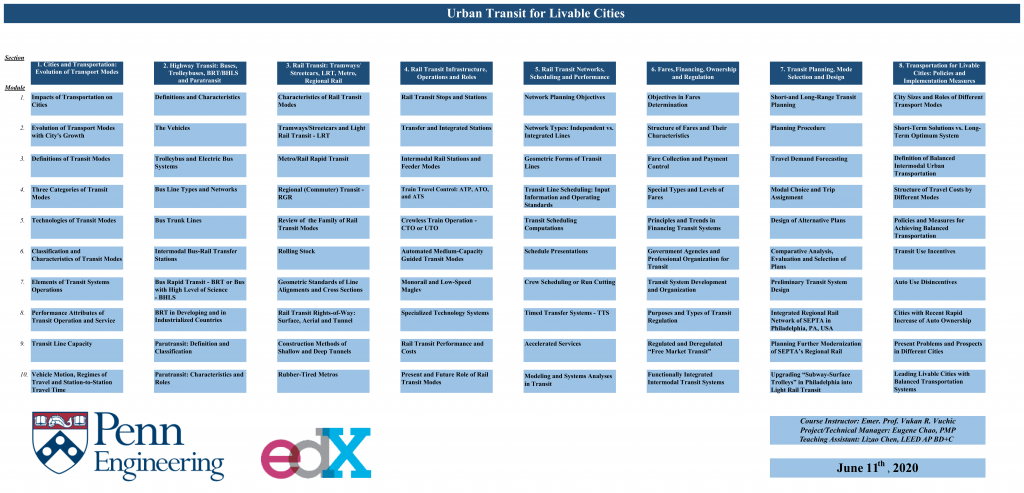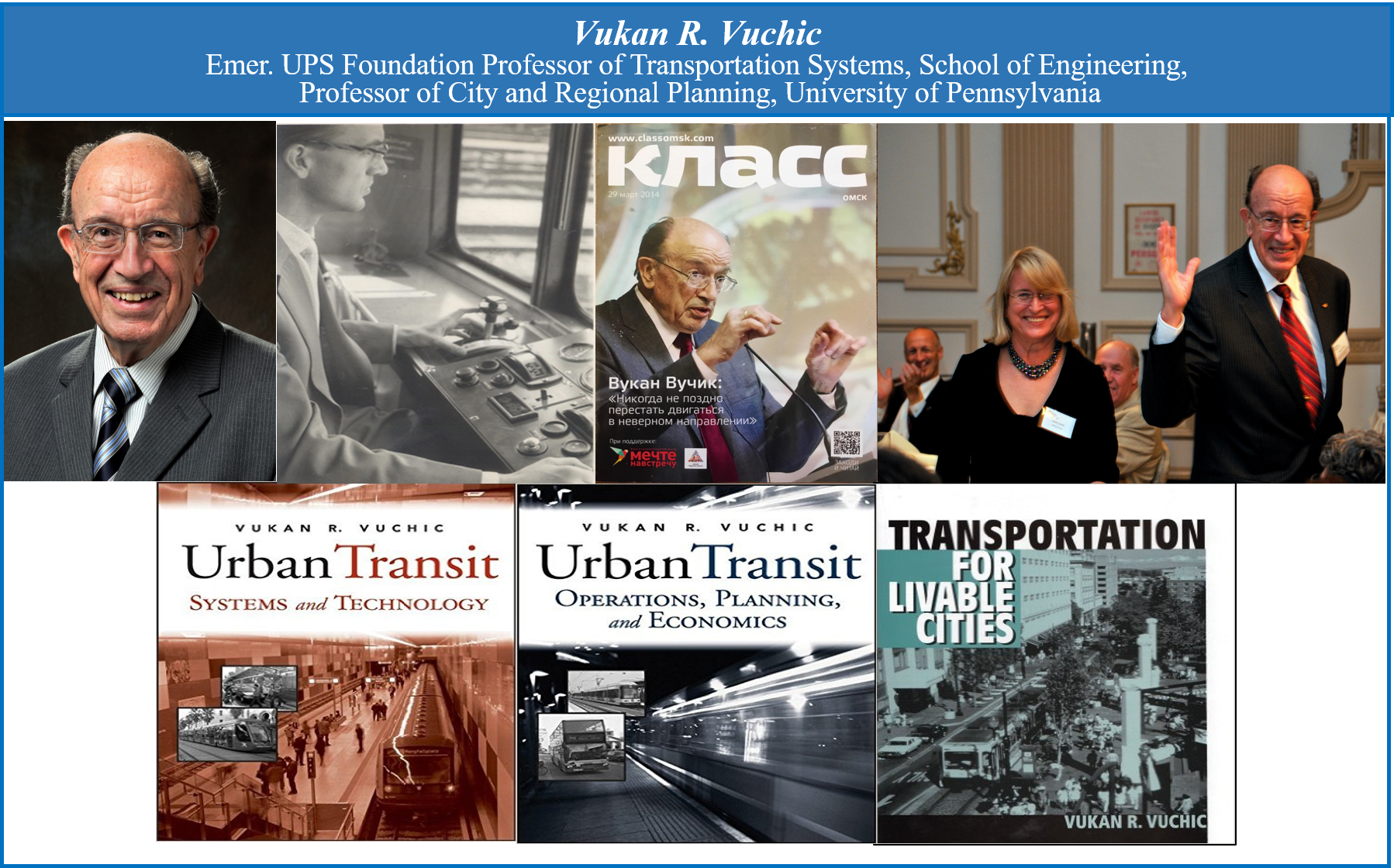
The course will cover urban transportation theory and examples from different cities and countries. It will compare physical characteristics, transportation policies, and evaluations of their strengths and weaknesses. (Please find more information from the syllabus).
Syllabus
- Cities and Transportation: Evolution of Transit Modes
1.1 Impacts of Transportation on Cities
1.2 Evolution of Transport Modes with City’s Growth
1.3 Definitions of Transit Modes
1.4 Three Categories of Transit Modes
1.5 Technologies of Transit Modes
1.6 Classification and Characteristics of Transit Modes
1.7 Elements of Transit Systems Operations
1.8 Performance Attributes of Transit Operation and Service
1.9 Transit Line Capacity
1.10 Vehicle Motion, Regimes of Travel and Station-to-Station Travel Time - Highway Transit: Buses, Trolleybuses, BRT/BHLS and Paratransit
2.1 Definitions and Characteristics
2.2 The Vehicles
2.3 Trolleybus and Electric Bus Systems
2.4 Bus Line Types and Networks
2.5 Bus Trunk Lines
2.6 Intermodal Bus-Rail Transfer Stations
2.7 Bus Rapid Transit – BRT or Bus with High Level of Serice – BHLS
2.8 BRT in Developing and in Industrialized Countries
2.9 Paratransit: Definition and Classification
2.10 Paratransit: Characteristics and Roles - Rail Transit: Tramways/Streetcars, LRT, Metro, Regional Rail
3.1 Characteristics of Rail Transit Modes
3.2 Tramways/Streetcars and Light Rail Transit – LRT
3.3 Metro/Rail Rapid Transit
3.4 Regional (Commuter) Rail – RGR
3.5 Review of the Family of Rail Transit Modes
3.6 Rolling Stock
3.7 Geometric Standards of Line Alignments and Cross Sections
3.8 Rail Transit Rights-of-Way: Surface, Aerial and Tunnel
3.9 Construction Methods of Shallow and Deep Tunnels
3.10 Rubber-Tired Metros - Rail Transit Infrastructure, Operations and Roles
4.1 Rail Transit Stops and Stations
4.2 Transfer and Integrated Stations
4.3 Intermodal Rail Stations and Feeder Modes
4.4 Train Travel Control: ATP, ATO and ATS
4.5 Crewless Train Operation – CTO or UTO
4.6 Automated Medium-Capacity Guided Transit Modes
4.7 Monorails and Low-Speed Maglev
4.8 Specialized Technology Systems
4.9 Rail Transit Performance and Costs
4.10 Present and Future Roles of Rail Transit Modes - Rail Transit Network, Scheduling and Performance
5.1 Network Planning Objectives
5.2 Network Types: Independent vs. Integrated Lines
5.3 Geometric Forms of Transit Lines
5.4 Transit Line Scheduling: Input Information and Operating Standards
5.5 Transit Scheduling Computations
5.6 Schedule Presentations
5.7 Crew Scheduling or Run Cutting
5.8 Timed Transfer Systems – TTS
5.9 Accelerated Services
5.10 Modeling and Systems Analyses in Transit - Fares, Financing, Ownership and Regulation
6.1 Objectives in Fares Determination
6.2 Structure of Fares and Their Characteristics
6.3 Fare Collection and Payment Control
6.4 Special Types and Levels of Fares
6.5 Principles and Trends in Financing Transit Systems
6.6 Government Agencies and Professional Organizations for Transit
6.7 Transit System Development and Organization
6.8 Purposes and Types of Transit Regulation
6.9 Regulated and Deregulated “Free Market Transit”
6.10 Functionally Integrated Intermodal Transit Systems - Transit Planning, Mode Selection and Design
7.1 Short- and Long-Range Transit Planning
7.2 Planning Procedure
7.3 Travel Demand Forecasting
7.4 Modal Choice and Trip Assignment
7.5 Design of Alternative Plans
7.6 Comparative Analysis, Evaluation and Selection of Plans
7.7 Preliminary Transit System Design
7.8 Integrated Regional Rail Network of SEPTA in Philadelphia, PA, USA
7.9 Planning Further Modernization of SEPTA’s Regional Rail
7.10 Upgrading “Subway-Surface Trolleys” in Philadelphia into Light Rail Transit - Transportation for Livable Cities: Policies and Implementation Measures
8.1 City Sizes and Roles of Different Transport Modes
8.2 Short-Term Solutions vs. Long-Term Optimum System
8.3 Definition of Balanced Intermodal Urban Transportation
8.4 Structure of Travel Costs by Different Modes
8.5 Policies and Measures for Achieving Balanced Transportation
8.6 Transit Use Incentives
8.7 Auto Use Disincentives
8.8 Cities with Rapid Increase of Auto Ownership
8.9 Present Problems and Prospects in Different Cities
8.10 Leading Livable Cities with Balanced Transportation System
Target audience
The course is designed for transportation engineers, city planners and other people interested in city planning. It is also well-suited for graduate and advanced undergraduate students of transportation, civil, environmental, mechanical, electrical and systems engineering, business administration, economics, and architecture.
Learners interested in transportation engineering and city planning will gain expert insight into the critical role transit services have in the character of city and quality of life.
Online Course Trailer
